Related Research Articles

Taddeo Zuccaro was an Italian painter, one of the most popular members of the Roman mannerist school.

Imola is a city and comune in the Metropolitan City of Bologna, located on the river Santerno, in the Emilia-Romagna region of northern Italy. The city is traditionally considered the western entrance to the historical region Romagna.

Faenza is an Italian city and comune of 59,063 inhabitants in the province of Ravenna, Emilia-Romagna, situated 50 kilometres southeast of Bologna.
Ottaviano Nonni, called Il Mascherino, was an Italian architect, sculptor, and painter born in Bologna. Apprentice of Giacomo Barozzi da Vignola, he was active in Emilia and in Rome, where he had been living in the rione of Borgo, in the road still bearing his name.
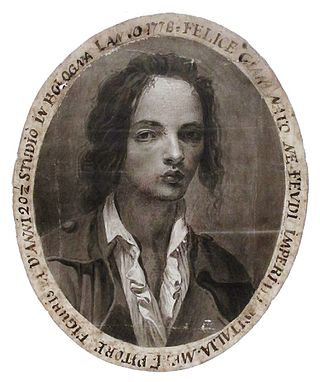
Felice Giani was an Italian painter of the Neoclassic style. His grand manner subjects often included Greco-Roman allusions or themes.

Vittorio Bigari was an Italian painter of the late-Baroque period.

Fermo Guisoni was an Italian painter of the Renaissance period, active mainly in his native city of Mantua.
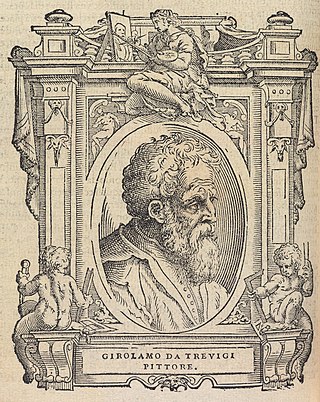
Girolamo da Treviso, also known as Girolamo di Tommaso da Treviso the Younger and Girolamo Trevigi, was an Italian Renaissance sculptor and painter in Henry VIII's court in England.
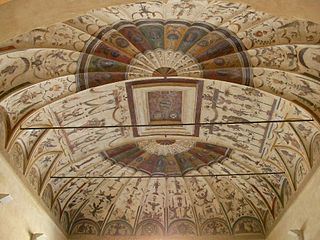
Marco Marchetti was an Italian painter of the late-Renaissance or Mannerist period. Born in Faenza, he is also known as Marco da Faenza. He painted an Adoration by the shepherds (1567) originally in the church of the confraternity of Santa Maria dell'Angelo, but now in the pinacoteca of Faenza. He also painted along with Giorgio Vasari a series of frescoes in the Palazzo Vecchio representing the Life of Hercules. He painted an altarpiece representing the Martyrdom of St. Catherine of Alexandria (1580) in the church of Sant'Antonio in Faenza.

Jacopo Bertucci was an Italian painter of the Renaissance period. He is also known as Jacopone da Faenza. He was born in Faenza, and worked under Raphael in Rome. One of his pupils was Taddeo Zuccari. He was active c. 1530 and painted in the manner of Raphael. He painted for the church of San Vitale at Ravenna. He died at the age of 20.
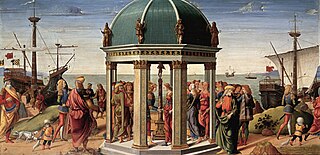
Biagio d’Antonio Tucci was an Italian Renaissance painter active in Florence, Faenza and Rome.

Francesco da Cotignola, also called Zaganelli, was an Italian painter of the Renaissance period, active mainly in Parma and Ravenna.
Giulio Tonduzzi was an Italian painter of the Renaissance period.
Giovanni Battista della Marca (1532–1587) was an Italian painter of the Renaissance period.

Ottaviano Dandini was the son of Pietro Dandini, and painted history in the style of his father. Some fresco paintings in the cloister of San Spirito, a picture of several Saints in San Lorenzo, and his works in the church of the Magdalene at Pescia, evince the respectability of his talent. He afterward entered the Society of Jesus, and died about 1750.
Luzio Dolci or Lucio Dolce was a late 16th-century Italian painter active in Castel Durante in the Province of Pesaro and Urbino in the Region of the Marche.

Giovanni Battista da Faenza, called Bertucci, who painted in the style of Perugino and Pinturicchio, flourished in the early part of the 16th century at Faenza. In the Pinacoteca of that city there are various works ascribed to him, of which the most remarkable is a Majesty, signed by him and bearing the date 1506. Crowe and Cavalcaselle also claim for Bertucci an Adoration of the Magi in the Berlin Gallery, there ascribed to Pinturicchio, and a Glorification of the Virgin in the National Gallery, given in the catalogue to Lo Spagna, who was a pupil of Perugino.

Pace di Bartolo or Pace da Faenza was an Italian painter, active in Assisi in 1344-1368.

Ottaviano Fregoso was the Doge of the Republic of Genoa.
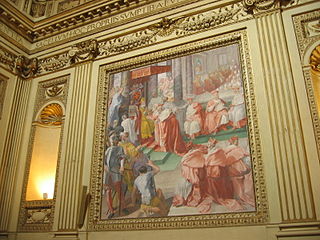
Pasquale Cati was an Italian Mannerist painter active mostly in Rome.
References
 This article incorporates text from a publication now in the public domain : Bryan, Michael (1886). "Faenza, Ottaviano da". In Graves, Robert Edmund (ed.). Bryan's Dictionary of Painters and Engravers (A–K). Vol. I (3rd ed.). London: George Bell & Sons.
This article incorporates text from a publication now in the public domain : Bryan, Michael (1886). "Faenza, Ottaviano da". In Graves, Robert Edmund (ed.). Bryan's Dictionary of Painters and Engravers (A–K). Vol. I (3rd ed.). London: George Bell & Sons.